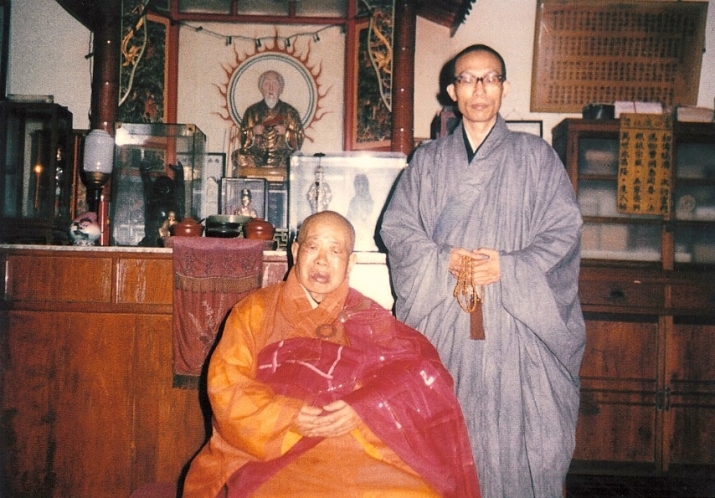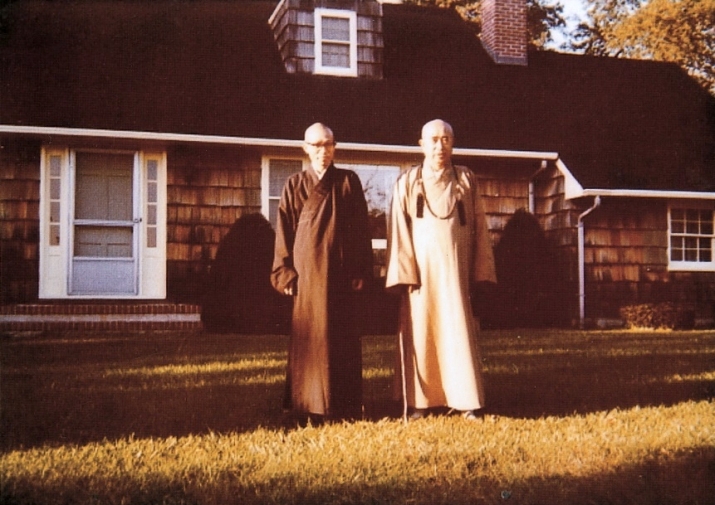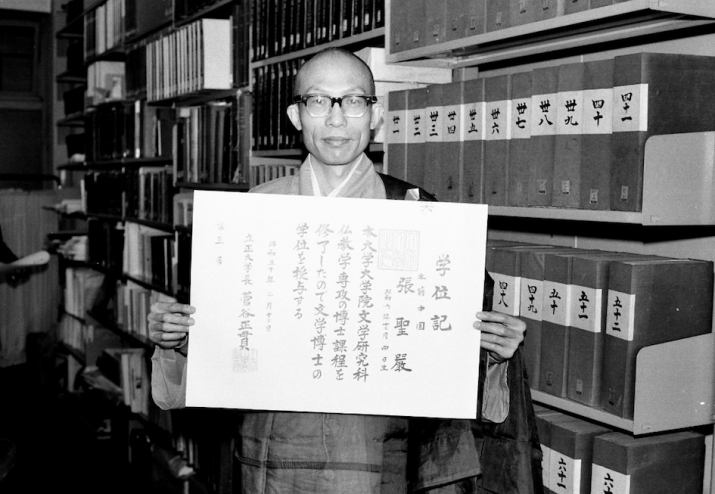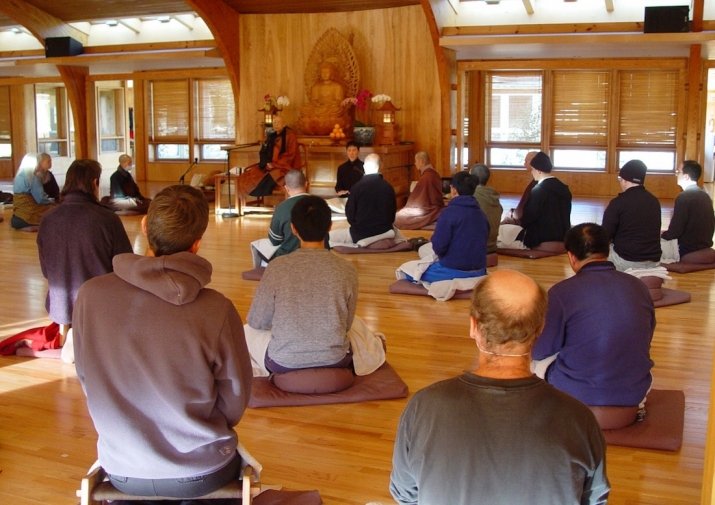FEATURES|THEMES|Philosophy and Buddhist Studies
Approaching Chan, Part 2: The Two Streams of Chan Contemplative Practices
When Chan Buddhist practices were first transmitted to China, they were the same as those practiced in India. Over time, however, the contemplative practices (禪觀) of Chan in China diverged into two distinct streams: the Tiantai school’s Śamatha-vipaśyanā, a combination of Hinayana and Mahayana practices from India, and the Chan school’s current methods of Huatou (話頭) and Silent Illumination (默照) contemplation, which are derived from Mahayana Chan in India. (Master Sheng Yen 1980a, 47)
1. The Chan practices developed in the Tiantai school
Tiantai is an indigenous Chinese school of Buddhism that takes the Lotus Sutra as the basis for its core teachings, with a dual-pronged emphasis on doctrine and practice. The development of the Tiantai school originated with the concept of ”One Mind (Engages), Three Discernments (Meditations)” (一心三觀) proposed by the school’s First Patriarch, Master Huiwen (c. mid-6th century). The Second Patriarch, Master Huisi (515–77), further developed the “samadhi of half walking and half sitting” practice and the “samadhi of neither walking nor sitting” practice, as way of applying the “One Mind, Three Discernments” in daily life. This represented a significant breakthrough in Chinese Chan thought and was the forerunner of the later Chan school, which emphasizes that “the Way is in daily life.”
The Third Patriarch, Master Zhiyi (538–97), combined two contemplative practices from India and two from Master Huisi into four kinds of practice* in the treatise Mahā-śamatha-vipaśyanā (摩訶止觀). Master Zhiyi also inherited Master Huisi’s three types of Śamatha-vipaśyanā and made them a complete system of practice. The three types of Śamatha-vipaśyanā are:
1. Gradual Advancement Śamatha-vipaśyanā. While in his 30s, Master Zhiyi analyzed and compared in great detail all the gradual contemplation practices from India and wrote the well-known book, The Sequential Practices of Dhyāna Pāramitā (釋禪波羅蜜次第法門).
2. Indeterminate Śamatha-vipaśyanā. During middle age, Master Zhiyi wrote The Six Excellent Approaches for Practicing Meditation (六妙門) and the Concise Śamatha-vipaśyanā (小止觀) to help practitioners of various levels of ability practice Śamatha-vipaśyanā. These include guidelines for settling the body and mind before practicing the methods, methods for concentrating the mind, and how to practice in daily life while standing, sitting, working, or resting.
3. Perfect and Sudden Śamatha-vipaśyanā. When he reached old age, Master Zhiyi started to use the Śamatha-vipaśyanā system to summarize all the Buddhadharma. He completed a very detailed and systematic book titled Mahā-śamatha-vipaśyanā (摩訶止觀).
(Chung-Hwa Buddhist Journal. No. 14. 2001. See also Master Sheng Yen 1980b, 5–20)
 Master Sheng Yen received the Linji lineage from Master Lingyuan. Image courtesy of Dharma Drum Cultural Center
Master Sheng Yen received the Linji lineage from Master Lingyuan. Image courtesy of Dharma Drum Cultural CenterThe late Chan Master Sheng Yen (1930–2009) was not a Tiantai expert, yet both his master’s and his doctoral theses focused on the Tiantai school. He frequently used Tiantai teachings to help newcomers begin with the gradual methods of contemplation to establish a foundation for practicing the sudden methods. He would always remind practitioners that the purpose of practice is the practice itself, and that the practice has two aspects: to clarify the concepts and to be actualized in daily life.
In short, after practitioners had built a practical foundation for meditating and focusing their minds, Master Sheng Yen would introduce direct contemplation and contemplation of the Middle Way (seeing emptiness), or the practice of the sudden methods, such as Huatou and Silent Illumination.
2. The development of Chan practices
The Chan school emerged 100–200 years later than the Tiantai school. Since Bodhidharma, the First Patriarch of the Chan school, came to China, the school has adapted to accommodate changing times and regional differences, and its style and content have gone through a number of major evolutions. According to the research of modern scholars, at least three major transformations have taken place.
 Master Sheng Yen received the Soto Lineage from Master Dongchu. Image courtesy of Dharma Drum Cultural Center
Master Sheng Yen received the Soto Lineage from Master Dongchu. Image courtesy of Dharma Drum Cultural CenterThe first period: from Bodhidharma’s arrival in China to the passing of the Sixth Patriarch Huineng (~190 years)
Bodhidharma introduced his treatise Two Entrances and Four Practices (二入四行) to China. “The Entrance of Principle” teaches the practitioner to meditate without having any thoughts in the mind. “The Entrance to Practice” introduces four methods to be practiced in daily life—the Practice of Repaying Grievances, the Practice of Being in Accordance with Conditions, the Practice of Not Seeking, and the Practice of Abiding in the Dharma.** (Master Sheng Yen 2015, 25)
The Chan lineage was eventually transmitted to Master Huineng (638–713), whose teachings and practices are detailed in The Sixth Patriarch Platform Sutra. For example: “Do not think of good or evil. At this precise moment, where is your original face?” On another occasion, Master Huineng explained: “The Dharma-method that I teach takes concentration and wisdom as its foundation. Yet everyone here should not be confused and think that samadhi (concentration) and wisdom are different . . . in actuality, when wisdom manifests, concentration is within wisdom; when concentration is attained, wisdom is within concentration.”
The essence of the Sixth Patriarch’s teachings, which is also the essence of the Sixth Patriarch Platform Sutra, are the concepts of “no thought,” “non-abiding,” and “no form.” These teachings are similar to the frequent instructions Master Sheng Yen would give when leading Chan practice to help practitioners to let go of attachment. (Master Sheng Yen 2015, 31)
The second period: the 250 years after the Sixth Patriarch Huineng
From the passing of Master Huineng to the end of the Five Dynasties (713–959), some 250 years, the Chan school produced many great masters. Over time, the many disciples in the Sixth Patriarch’s lineage developed five distinct schools of Chan, each with its own style and character: Weishan Lingyou and Yangshan Huiji founded the Weiyang School, Huangpo Xiyun and Linji Yixuan founded the Linji School, Yunmen Wenyan founded the Yunmen School, Dongshan Liangjie and Caoshan Benji founded the Caodong School, and Fayan Wenyi founded the Fayan School. Of the five, Linji and Caodong are the only schools that have survived to the present day. (Master Sheng Yen 1980a, 62–68)
 In 1975, Master Sheng Yen received his doctorate in Buddhist literature from Rissho University in Japan. Image courtesy of Dharma Drum Cultural Center
In 1975, Master Sheng Yen received his doctorate in Buddhist literature from Rissho University in Japan. Image courtesy of Dharma Drum Cultural CenterThe third period: the beginning of the Song dynasty to the Ming and Qing dynasties (~1,000 years)
Chan Buddhism had already matured by the end of the Tang dynasty (618–907). Chan Master Yongming Yanshou (904–975) and other eminent teachers further advocated and integrated various practices, such as upholding mantras, reciting the Buddha’s name/being mindful of the Buddha, prostrating to the Buddha, repenting of past karma, circumambulating, and chanting sutras. Consequently, the prevailing understanding from this period until the present day has been that the practices of Chan and Pure Land Buddhism are complementary and that their esoteric and exoteric teachings come from the same source. (Master Sheng Yen 1980a, 85. See also Master Sheng Yen 2015, 25)
Master Sheng Yen was born during a time of war and political upheaval. Although he became a monk at a young age, he was unable to find a good teacher under whom to study Chan. The monastery in which he resided also lacked a complete system of education. He later enlisted in the army and migrated to Taiwan, where he once again became a monastic, practicing in solitude for six years. Enduring great hardships, he attained a doctorate while in Japan and taught Buddhism in the United States. During this period, he had no monastery to call home, however despite such difficulties, Master Sheng Yen later observed that his days wandering homeless in the streets were the most burden-free times of his life. It was while living in this unstable and turbulent environment that he received the Dharma-lineages of the Linji and Caodong schools. (Master Sheng Yen 2008)
 Master Sheng Yen giving a Dharma talk during a retreat at the Dharma Drum Retreat Center in New York. He led more than 300 such retreats worldwide. Image courtesy of Dharma Drum Cultural Center
Master Sheng Yen giving a Dharma talk during a retreat at the Dharma Drum Retreat Center in New York. He led more than 300 such retreats worldwide. Image courtesy of Dharma Drum Cultural CenterIn describing his own spiritual practice, Master Sheng Yen said: “I had many illnesses throughout my life and the obstructions from my karmic actions were great. Yet, I came upon my initial realization in my Chan practice during a period when my work in the army was especially demanding. . . . At that time, my body was constantly ill and my work was very difficult, however I still set aside time every day to read the sutras, make prostrations to the Buddhas, and sit in meditation. I devoted myself fully to my practice without giving up. . . . My religious experiences did not result only from being in solitary retreat in the mountains, and my foundation in studying Buddhism was not only established in my studies abroad in Tokyo—this is why I often say these two sentences: ‘The busiest people have the most time. The most hardworking people have the best health.’” (Master Sheng Yen 2005, 72)
Chan, then, is certainly not limited to simply meditating. Rather, Chan is seizing every moment and working hard at all times. This is Master Sheng Yen’s approach to, and vision of, Chan practice.
Venerable Guo-Xing is the abbot and Venerable Chang-Hwa is the director of the Chan Meditation Center, New York. The authors would like to acknowledge the invaluable translation and editing work for this article by Yayun Anny Sung.
Images courtesy of the Chan Meditation Center, New York
* The four types of Samadhi:
1. “The Samadhi of Continuous Sitting” is the most commonly adopted method of traditional Chan practitioners.
2. “The Samadhi of Continuous Walking,” also called “Pratyutpanna-samadhi,” is used by Pure Land practitioners.
3. “The Samadhi of Half Walking and Half Sitting” is used on seven-day “Vaipulya samadhi” retreats and 21-day “Huayen samādhi retreats.”
4. “The Samadhi of Neither Walking nor Sitting,” also known as “The Samadhi of Following One's Own Thoughts,” is used on 49-day “Samadhi of Guanyin” retreats and 21-day “Samadhi of Great Compassion” retreats.
** As Master Sheng Yen explained:
1. “The Practice of Repaying Grievances:” When you encounter unfavorable situations, do not complain. The situation is the result of past karmic deeds.
2. “The Practice of Being in Accordance with Conditions:” When you encounter good fortune and favorable circumstances, do not be too happy. This good fortune is the result of your hard work in the past and various facilitating conditions in the present.
3. “The Practice of Not Seeking:” In everything you do, do not have an ulterior motive. Do the action for the action itself; practice for the practice itself.
4. “The Practice of abiding in the Dharma:” Do what you are supposed to do; do what you are able to do. Refrain from doing or not doing things from your own subjective point of view.
References
Master Sheng Yen. 1980a. Chan de Tiyan Chan de Kaishi (禪的體驗: 禪的開示). Taipei: Dongchu Publishing.
Chung-Hwa Buddhist Journal. No. 14. 2001. Taipei: The Chung-Hwa Institute of Buddhist Studies.
Master Sheng Yen. 1980b. “Zhongguo Fojiao de Tese—Chan yu Chanzong” (“中國佛教的特色----禪與禪宗”) in Huagan Buddhist Newsletter Vol. 4.
Master Sheng Yen. 2015. The World of Chan. Taipei: Dharma Drum Cultural Center.
Master Sheng Yen. 2008. Footprints in the Snow: The Autobiography of a Chinese Buddhist Monk. New York: Doubleday.
Master Sheng Yen. 2005. Wubai Pusa Zoujianghu (五百菩薩走江湖). Taipei: Fagu Wenhua.
See more
Related
Approaching Chan, Part 1 (Buddhistdoor Global)
Approaching Chan, Part 3: The Methods of Lingji’s Huatou and Caodong’s Silent Illumination (Buddhistdoor Global)














